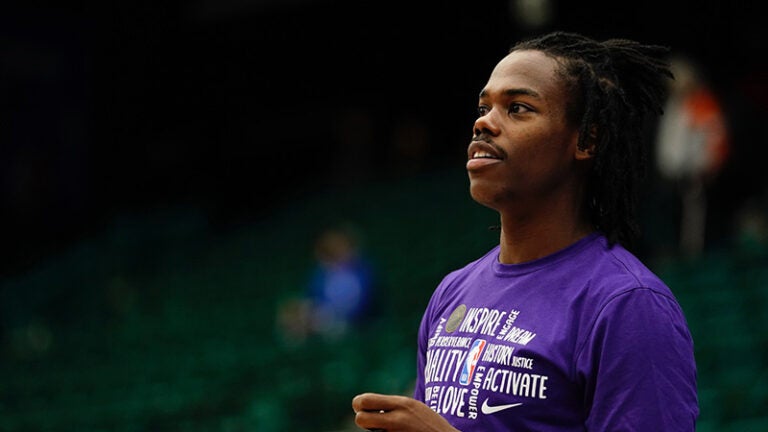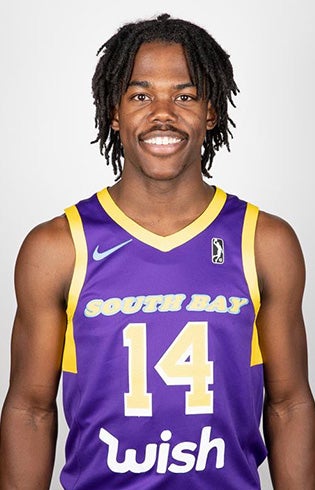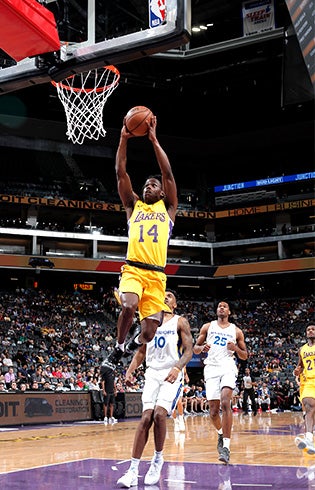
Former South Bay Lakers point guard shooting for medical school gets an assist from USC Dornsife
Highlights:
Marcus Allen played basketball for the Los Angeles Lakers’ G-league team.
Looking for a new career track, Allen aimed for medicine, inspired by his physician parents and his team doctors.
USC Dornsife’s postbaccalaureate premedical program, designed for students with little to no science background, proved the right choice for him.
The program also prepares students for dental, veterinary or pharmacy school.
Many children grow up dreaming of being a doctor or a sports professional, but Marcus Allen is on his way to achieving the almost impossible feat of succeeding as both.
Allen played basketball at Stanford University before being drafted to the South Bay Lakers, the Los Angeles Lakers’ G-league team. He left the basketball court in 2020 and about a year later began the Postbaccalaureate Premedical Program at the USC Dornsife College of Letters, Arts and Sciences.

“Basketball was a great experience, but I didn’t see myself doing it as a career,” says Allen, who earned a bachelor’s degree in psychology from Stanford. “Both my parents are doctors, so I thought about going into medicine, and being around all the team doctors at Stanford and with the Lakers, I realized I wanted to go into the medical field and hopefully become a team physician myself one day.”
No science? No problem
The program, which launched more than two decades ago, is designed for students with at least a bachelor’s degree who had little or no science education at the college level. In addition to providing them with the coursework necessary to meet requirements for acceptance to medical, dental, pharmacy or veterinary schools, the program gives students clinical experience, test prep instruction and access to volunteer activities that boost their practical knowledge.
Students can finish the coursework in four to five semesters, spanning a year and a half to two years. A third, “glide” year comprises medical school applications and any additional coursework specific schools might require.
Applications are reviewed on a rolling admissions basis, and there is admission for fall, spring and summer cohorts.
Designed for ‘career changers’
Chiho Mak, professor of chemistry and quantitative and computational biology at USC Dornsife and the head of the program, says that it attracts students from a wide variety of fields, from law to visual arts to finance. Many of the students have had a few years of work experience under their belt before they enroll, he adds.
“Our program is focused on what we called ‘career changers,’ students who have been working in different fields but later realized that medicine is their calling,” Mak says. “A good portion of practicing physicians did not pursue pre-med studies as undergrads but later went through a postbac premed program.”
He adds that applicants do not need to have taken certain courses in college or worked in a science-related field: A bachelor’s degree and a minimum GPA are the only academic prerequisites. “We want students to understand that they can earn a bachelor’s degree in history or the arts or business and still go to medical school later, if they wish.”
Mak says that although the program only carries two courses per semester, it typically is a full-time program once volunteer time and clinical experience are added in.
Classes cover fundamentals in chemistry, biology and physics as well as some advanced instruction in those areas.
“Many other programs pack all of these courses into a one-year program,” says Mak, “but we have found that a two-year or one-and-a-half–year program is much easier because it gives students time to get back into the rhythm of being in school, given that many haven’t been for a while.” He adds that students without a science background might find a lot of intense instruction overwhelming, and a spaced-out curriculum gives them time to master concepts before moving on.
Enjoying that student feeling

Because Allen had taken a few premed courses on his own prior to enrolling, he only needed to complete the second year of coursework at USC Dornsife. He says that being an older student — he’s 28 — and his basketball career helped him learn how to be diligent and focused, two attributes he says he’s needed in prepping for medical school. But he enjoys the feeling of being a full-time student as well, something he says he missed a bit at Stanford because he had to devote a lot of time to training and playing basketball.
“I didn’t expect to have so much camaraderie with the other students in the program — we eat together, have beach days, stuff like that,” he says. “Even things like office hours, just talking with my TAs, I get to take advantage of everything school has to offer now.”
Although he would like to be a team doctor, Allen isn’t ruling out work in other areas. Health care disparities in underserved communities are a major issue, he says, and he would like to be able to work in some capacity to help ameliorate them.
Allen is currently applying to medical school but is unsure where he’ll go, though he hopes to be able to stay in L.A. The city, he says, is where his heart is now.